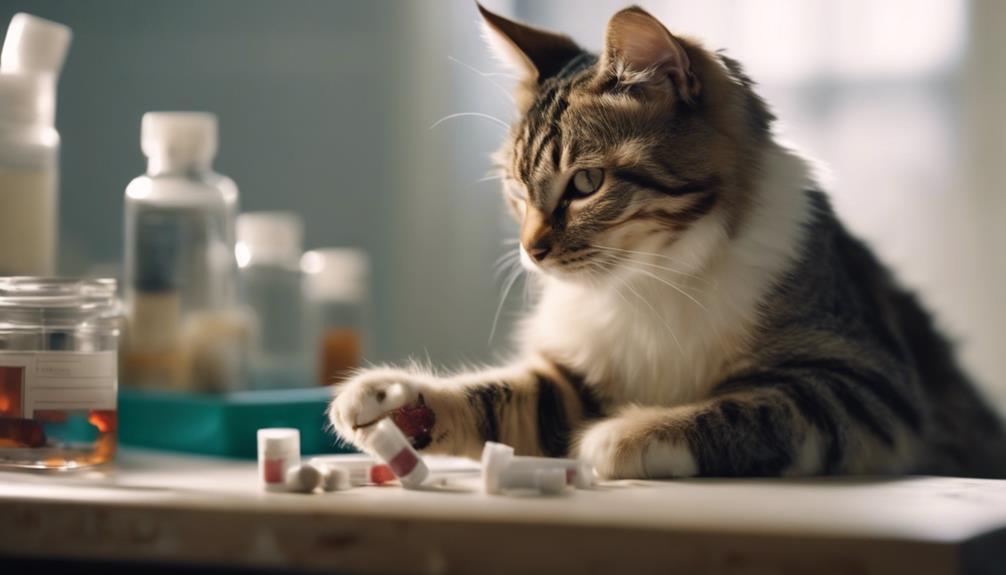Cat scratch fever, a prevalent concern among cat owners, is not only a potential health risk for felines but can also impact human health. Understanding the intricate details of this bacterial infection is crucial for pet owners seeking to protect their beloved companions.
From recognizing the symptoms to implementing preventive measures, a deeper insight into the causes, symptoms, and treatment options for cat scratch fever is indispensable in ensuring the well-being of both pets and their owners.
As we unravel the complexities of this condition, a proactive approach to safeguarding our favorite felines emerges, shedding light on effective prevention strategies and management techniques.
Key Takeaways
- Cat scratch fever is caused by Bartonella henselae bacteria from infected cats.
- Symptoms include rash, swollen lymph nodes, fever, and fatigue.
- Treatment involves antibiotics for severe cases in humans and infected cats.
- Prevention includes flea control in cats to reduce transmission risks.
Cat Scratch Fever Basics
Cat scratch fever, also known as cat scratch disease, is a bacterial infection caused by Bartonella henselae that is commonly transmitted through scratches, bites, or licking by infected cats. This condition typically presents with a bump at the site of exposure and is more prevalent in children, young adults, and those with weakened immune systems.
Symptoms may be hidden in skin folds, making early detection challenging. Understanding the causes and transmission of cat scratch fever is crucial for pet owners to protect themselves and their beloved felines. While the disease is usually self-limiting, it is essential to be aware of the risks associated with cat scratches and take preventive measures to minimize the chances of infection.
Bacterial Cause and Spread
Transmitted primarily through the bites, scratches, or licking of infected cats, cat scratch fever is caused by the bacteria Bartonella henselae. This bacterium is carried by fleas, ticks, and flies, making it easily transmittable between cats and potentially to humans. Cats carrying the bacteria typically show no symptoms, making it challenging to detect. The spread of this infection can occur through various means, including direct contact with an infected cat's saliva or through scratches. It's essential to be mindful of these modes of transmission to prevent the onset of cat scratch fever in both felines and humans.
- Bartonella henselae transmitted through bites, scratches, or licking.
- Cats show no symptoms despite carrying the bacteria.
- Direct contact with infected cat's saliva can spread the infection.
Symptoms and Diagnosis

Upon exposure to Bartonella henselae bacteria, individuals may experience a range of symptoms that characterize cat scratch fever, necessitating prompt diagnosis and treatment.
The primary indicator is a raised bump at the site of contact, often accompanied by a rash that typically appears 3 to 10 days post-exposure. Swollen and tender lymph nodes, along with systemic symptoms like fever, fatigue, and headache, are common manifestations.
Diagnosis usually involves evaluating clinical symptoms, potential contact with cats, and laboratory tests to confirm the presence of the bacteria. Given the varied presentation of symptoms, seeking medical attention promptly is crucial for accurate diagnosis and timely intervention to manage cat scratch fever effectively.
Risk Factors and Vulnerability
Individuals with certain predisposing factors are at heightened risk for developing cat scratch fever, necessitating a closer examination of the associated risk factors and vulnerabilities. While cat scratch fever can affect anyone, some individuals may be more vulnerable due to specific factors.
- Immunocompromised Conditions: Individuals with weakened immune systems are more susceptible to infections, including cat scratch fever.
- Young Age: Children, especially those under the age of 15, are at a higher risk of contracting cat scratch fever.
- Frequent Contact with Cats: Those who have close contact with cats, especially outdoor cats or strays, are more likely to be exposed to the bacteria that cause cat scratch fever.
Understanding these risk factors can help individuals take necessary precautions to prevent the disease.
Transmission to Humans

The transmission of cat scratch fever bacteria from felines to humans primarily occurs through direct contact with infected cats. When cats carrying the Bartonella henselae bacteria scratch, bite, or lick humans, the bacteria can enter the skin and cause infection. While rare, transmission can also happen through fleas that have fed on an infected cat.
It's important to be cautious, especially if you have a cat that likes to play rough or tends to scratch often. Keeping your cat's claws trimmed and practicing good hygiene, such as washing your hands after handling your cat, can help reduce the risk of transmission. Being aware of these potential transmission routes can help you take proactive steps to protect yourself and your loved ones from cat scratch fever.
Treatment Options Available
When addressing cat scratch fever, understanding the treatment options available is crucial for managing the infection and promoting recovery in both cats and humans. Treatment for cat scratch fever may vary depending on the severity of the infection. Here are some key options to consider:
- Symptomatic Relief: Providing pain relief and managing symptoms such as fever and fatigue.
- Antibiotics: Prescribed for severe cases to combat the bacterial infection effectively.
- Veterinary Care: Seeking professional help for infected cats, including potential antibiotic treatment and monitoring.
These treatment options aim to alleviate discomfort, eliminate the bacteria, and support the overall recovery process for both feline companions and their human caregivers.
Antibiotics for Infections

Effective treatment for bacterial infections often involves the use of antibiotics to target and eliminate the underlying cause of the illness.
When it comes to cat scratch fever caused by Bartonella henselae bacteria, antibiotics play a crucial role in managing severe cases. In situations where the infection has spread or intensified, antibiotics prescribed by a veterinarian can aid in combating the bacteria and reducing symptoms.
It is essential to follow the prescribed antibiotic regimen diligently to ensure the infection is properly treated. While most cases of cat scratch fever resolve without treatment, antibiotics become necessary to address more severe infections and prevent complications.
Consulting a veterinarian for appropriate antibiotic treatment is vital in safeguarding your cat's health and well-being.
Importance of Flea Control
Implementing a comprehensive flea control regimen is essential for maintaining the health and well-being of your feline companions. Fleas not only cause discomfort for your cat but also pose significant health risks.
Here are some key reasons why flea control is crucial:
- Fleas can transmit diseases and parasites to your cat, leading to various health issues.
- Flea infestations can quickly spread to other pets and even to your home environment.
- Regular flea control helps prevent skin irritations, allergic reactions, and potential infections in your beloved feline friend.
Prevention in Cats

To safeguard your cat against cat scratch fever, prioritizing preventive measures is paramount in maintaining their overall health and well-being. Regularly grooming your cat and ensuring they are free of fleas and ticks can significantly reduce the risk of infection.
Providing a nutritious diet, engaging in interactive playtime, and creating a stress-free environment can boost their immune system and overall well-being. Additionally, scheduling routine check-ups with your veterinarian for vaccinations and health screenings is essential in preventing potential illnesses.
Protecting Other Pets
In extending the focus beyond safeguarding cats from cat scratch fever, it is crucial to consider preventative measures that can protect other pets in the household. Other pets are also vulnerable to the risks associated with this disease, and taking proactive steps can help keep all furry friends safe.
Here are some ways to protect other pets:
- Regularly check all pets for signs of fleas and ticks.
- Ensure all pets receive appropriate vaccinations and preventive care.
- Keep all pets indoors to reduce their exposure to potentially infected animals.
Taking these precautions will help create a safer environment for all pets in the household, minimizing the risk of cat scratch fever and other related illnesses.
Zoonotic Risk Awareness

Awareness of zoonotic risks is essential in safeguarding both human and animal health in shared environments. Zoonotic diseases, such as cat scratch fever, can be transmitted between animals and humans. Understanding the risks associated with these infections is crucial for pet owners to protect themselves and their beloved feline companions.
By recognizing the potential for zoonotic transmission, individuals can take preventative measures to minimize the spread of diseases like cat scratch fever. This includes practicing good hygiene, promptly treating any scratches or bites, and seeking veterinary care for pets showing symptoms of illness.
Promoting Pet Health
Promoting optimal well-being for companion animals is a cornerstone of responsible pet ownership. Ensuring your pet's health and happiness involves more than just providing food and shelter. Here are a few key ways to promote your pet's health:
- Regular veterinary check-ups: Schedule routine visits to monitor your pet's overall health and catch any potential issues early.
- Proper nutrition: Feed your pet a balanced diet tailored to their specific needs to support their well-being.
- Mental and physical stimulation: Engage your pet with interactive toys, regular exercise, and social interaction to keep them mentally and physically healthy.
Frequently Asked Questions
Can Cat Scratch Fever Be Transmitted From Cats to Other Household Pets Besides Humans?
Cat scratch fever can be transmitted from cats to other household pets besides humans. Although rare, infected cats can transfer the Bartonella henselae bacteria to other pets through scratching, biting, or grooming, emphasizing the importance of monitoring all pets for potential symptoms.
Are There Any Specific Breeds of Cats That Are More Susceptible to Carrying the Bartonella Henselae Bacteria?
While there is no evidence to suggest that specific cat breeds are more susceptible to carrying Bartonella henselae bacteria, any cat can potentially harbor the infection. Regular veterinary check-ups, flea prevention, and good hygiene practices are essential for all cat owners.
How Long Does Cat Scratch Fever Typically Last in Cats if Left Untreated?
Untreated cat scratch fever in cats can last for several weeks to several months, with symptoms varying in severity. Prompt veterinary care is crucial to prevent complications and ensure a quicker recovery for feline patients.
Is It Possible for a Human to Develop Cat Scratch Fever From an Indirect Contact With an Infected Cat, Such as Sharing Bedding or Furniture?
Indirect contact, like sharing bedding or furniture, can lead to cat scratch fever in humans if the cat has infected the surfaces with bacteria. Proper hygiene and avoiding contact with potentially contaminated items are crucial preventive measures.
Are There Any Natural Remedies or Alternative Treatments Available for Cat Scratch Fever in Cats Besides Antibiotics?
While antibiotics are the mainstay treatment for cat scratch fever in cats, some natural remedies like supportive care, good nutrition, and stress reduction could aid recovery. However, consult a veterinarian for the most effective treatment plan.
Conclusion
In conclusion, understanding the causes, symptoms, and treatment options for cat scratch fever is crucial for pet owners to protect their beloved feline companions.
By implementing preventive measures such as flea control, prompt medical attention, and zoonotic risk awareness, pet owners can effectively manage and reduce the spread of this bacterial infection.
Overall, prioritizing the health and well-being of pets through proper care and awareness is essential in preventing and mitigating the risks associated with cat scratch fever.




